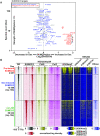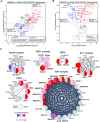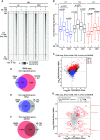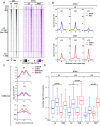SUMOylation regulates the protein network and chromatin accessibility at glucocorticoid receptor-binding sites
- PMID: 33524141
- PMCID: PMC7913686
- DOI: 10.1093/nar/gkab032
SUMOylation regulates the protein network and chromatin accessibility at glucocorticoid receptor-binding sites
Abstract
Glucocorticoid receptor (GR) is an essential transcription factor (TF), controlling metabolism, development and immune responses. SUMOylation regulates chromatin occupancy and target gene expression of GR in a locus-selective manner, but the mechanism of regulation has remained elusive. Here, we identify the protein network around chromatin-bound GR by using selective isolation of chromatin-associated proteins and show that the network is affected by receptor SUMOylation, with several nuclear receptor coregulators and chromatin modifiers preferring interaction with SUMOylation-deficient GR and proteins implicated in transcriptional repression preferring interaction with SUMOylation-competent GR. This difference is reflected in our chromatin binding, chromatin accessibility and gene expression data, showing that the SUMOylation-deficient GR is more potent in binding and opening chromatin at glucocorticoid-regulated enhancers and inducing expression of target loci. Blockage of SUMOylation by a SUMO-activating enzyme inhibitor (ML-792) phenocopied to a large extent the consequences of GR SUMOylation deficiency on chromatin binding and target gene expression. Our results thus show that SUMOylation modulates the specificity of GR by regulating its chromatin protein network and accessibility at GR-bound enhancers. We speculate that many other SUMOylated TFs utilize a similar regulatory mechanism.
© The Author(s) 2021. Published by Oxford University Press on behalf of Nucleic Acids Research.
Figures







Similar articles
-
SUMOylation inhibition potentiates the glucocorticoid receptor to program growth arrest of acute lymphoblastic leukemia cells.Oncogene. 2025 May;44(18):1259-1271. doi: 10.1038/s41388-025-03305-3. Epub 2025 Feb 14. Oncogene. 2025. PMID: 39953147 Free PMC article.
-
SUMOylation regulates the chromatin occupancy and anti-proliferative gene programs of glucocorticoid receptor.Nucleic Acids Res. 2014 Feb;42(3):1575-92. doi: 10.1093/nar/gkt1033. Epub 2013 Nov 4. Nucleic Acids Res. 2014. PMID: 24194604 Free PMC article.
-
GR SUMOylation and formation of an SUMO-SMRT/NCoR1-HDAC3 repressing complex is mandatory for GC-induced IR nGRE-mediated transrepression.Proc Natl Acad Sci U S A. 2016 Feb 2;113(5):E626-34. doi: 10.1073/pnas.1522821113. Epub 2015 Dec 28. Proc Natl Acad Sci U S A. 2016. PMID: 26712002 Free PMC article.
-
A conserved role for transcription factor sumoylation in binding-site selection.Curr Genet. 2019 Dec;65(6):1307-1312. doi: 10.1007/s00294-019-00992-w. Epub 2019 May 15. Curr Genet. 2019. PMID: 31093693 Review.
-
Regulation of transcription factors by sumoylation.Transcription. 2017 Aug 8;8(4):220-231. doi: 10.1080/21541264.2017.1311829. Epub 2017 Apr 5. Transcription. 2017. PMID: 28379052 Free PMC article. Review.
Cited by
-
SUMOylation inhibition potentiates the glucocorticoid receptor to program growth arrest of acute lymphoblastic leukemia cells.Oncogene. 2025 May;44(18):1259-1271. doi: 10.1038/s41388-025-03305-3. Epub 2025 Feb 14. Oncogene. 2025. PMID: 39953147 Free PMC article.
-
Impact of Histone Modifications and Their Therapeutic Targeting in Hematological Malignancies.Int J Mol Sci. 2022 Nov 7;23(21):13657. doi: 10.3390/ijms232113657. Int J Mol Sci. 2022. Retraction in: Int J Mol Sci. 2024 Mar 28;25(7):3762. doi: 10.3390/ijms25073762. PMID: 36362442 Free PMC article. Retracted. Review.
-
Sentinels of chromatin: chromodomain helicase DNA-binding proteins in development and disease.Genes Dev. 2021 Nov 1;35(21-22):1403-1430. doi: 10.1101/gad.348897.121. Genes Dev. 2021. PMID: 34725129 Free PMC article. Review.
-
EP300/CREBBP acetyltransferase inhibition limits steroid receptor and FOXA1 signaling in prostate cancer cells.Cell Mol Life Sci. 2024 Apr 2;81(1):160. doi: 10.1007/s00018-024-05209-z. Cell Mol Life Sci. 2024. PMID: 38564048 Free PMC article.
-
Genome-wide crosstalk between steroid receptors in breast and prostate cancers.Endocr Relat Cancer. 2021 Jul 22;28(9):R231-R250. doi: 10.1530/ERC-21-0038. Endocr Relat Cancer. 2021. PMID: 34137734 Free PMC article. Review.
References
Publication types
MeSH terms
Substances
LinkOut - more resources
Full Text Sources
Other Literature Sources
Molecular Biology Databases
Research Materials
Miscellaneous

